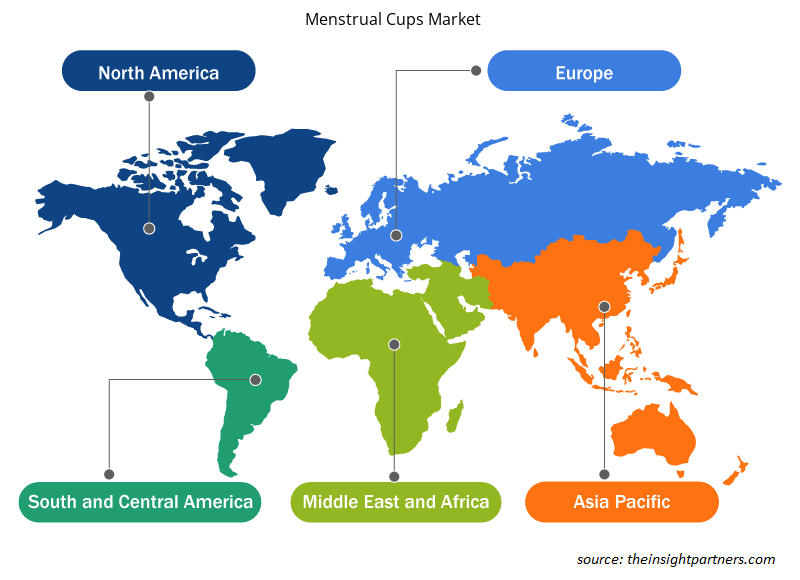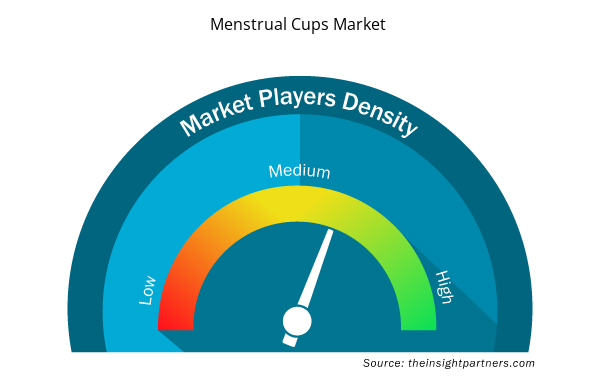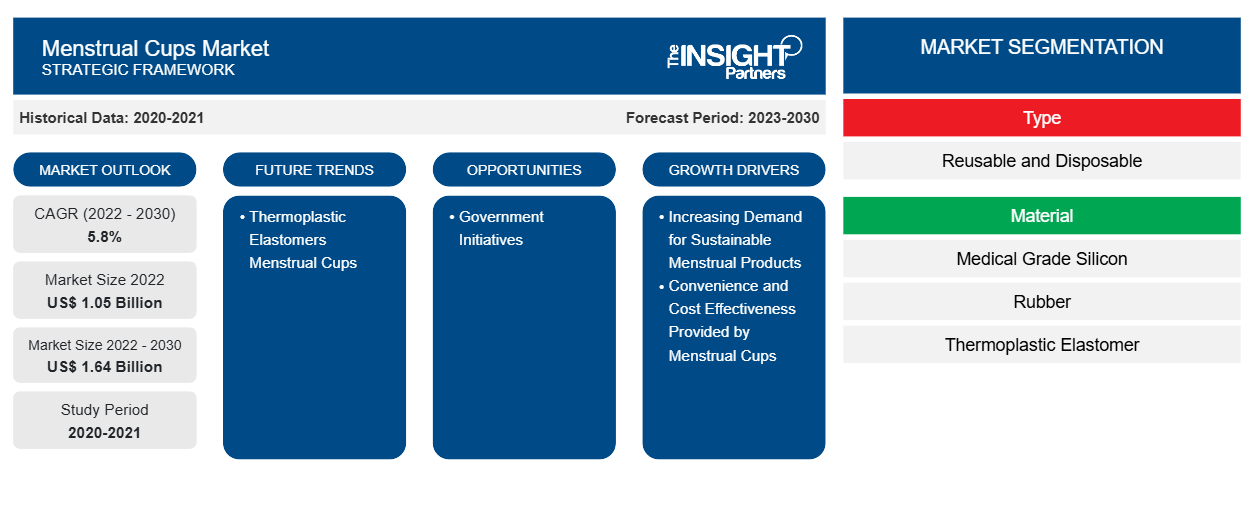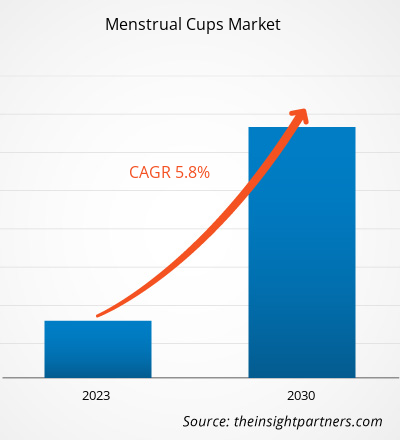[調査レポート] 月経カップ市場規模は2022年に10億5,081万米ドルと評価され、2030年までに16億4,406万米ドルに達すると予想されており、2022年から2030年にかけて5.8%のCAGRを記録すると予測されています。
市場洞察とアナリストの見解:
月経カップは、月経中の女性の衛生のために設計された、再利用可能なベル型の器具です。通常、医療グレードのシリコンまたはゴムで作られたこれらのカップは、従来のタンポンやナプキンのように月経液を吸収するのではなく、膣に挿入して月経液を収集します。漏れを防ぐために密閉し、空にするまで最大 12 時間着用できるため、使い捨て製品に代わる持続可能で費用対効果の高い選択肢となります。月経カップは、従来の月経衛生オプションと比較して、環境上の利点と長期的なコスト削減により人気が高まっています。
成長の原動力と課題:
持続可能な生理用品の需要の高まりは、月経カップ市場を推進する主な原動力です。近年、持続可能性への世界的なシフトがあり、消費者は従来の使い捨て生理用品の環境への影響をますます認識するようになりました。従来のナプキンとタンポンはプラスチック廃棄物に大きく貢献しており、その製造には資源とエネルギーの消費が伴います。毎年、平均的な女性は150キログラム近くの生分解性のない廃棄物を捨てています。インドだけでも、約1億2,100万人の女性と少女が平均して月に8枚の使い捨ておよび堆肥化できないナプキンを使用しており、毎月10億2,100万枚のナプキン廃棄物、年間123億枚のナプキン廃棄物、年間11万3,000トンの生理廃棄物を生み出しています。月経カップは再利用可能なため、個人が環境に優しい代替品を求める中で主要な選択肢として浮上しています。環境意識の高まりにより、消費者はエコロジカルフットプリントを最小限に抑える製品を選ぶようになり、月経カップの需要が高まっています。
持続可能な生理用品の需要増加は、女性の健康と幸福を擁護する幅広い運動と密接に関係しています。消費者は、環境に優しいだけでなく、安全で健康に有益な製品をますます優先するようになっています。月経カップは、通常、医療グレードのシリコン、ゴム、または熱可塑性エラストマーで作られており、安全で衛生的であると考えられており、従来の製品によく見られる炎症やアレルギー反応のリスクを軽減します。月経カップと環境の持続可能性および女性の健康の関連性は、その魅力に貢献し、人気の高まりの原動力となっています。
要件に合わせてレポートをカスタマイズする
このレポートの一部、国レベルの分析、Excelデータパックなど、あらゆるレポートを無料でカスタマイズできます。また、スタートアップや大学向けのお得なオファーや割引もご利用いただけます。
- このレポートの主要な市場動向を入手してください。この無料サンプルには、市場動向から見積もりや予測に至るまでのデータ分析が含まれます。
生理用品の持続可能性を求める声は、使い捨ての選択肢が環境に及ぼす影響についての認識を高めることを目的としたさまざまな擁護団体、NGO、政府の取り組みによって高まっています。持続可能な生理を促進するキャンペーンは、月経カップなどの再利用可能な代替品の利点について一般の人々を啓蒙する上で非常に重要です。持続可能な生理習慣の認知度と支持が高まることで、消費者の態度が前向きに変化し、月経カップの受容と採用が促進されます。
持続可能な生理用品の需要は、環境に配慮した選択を優先する若い世代の消費者によっても高まっています。特にミレニアル世代とジェネレーション Z は、パーソナルケアを含むさまざまな業界で持続可能で倫理的な製品の需要を牽引しています。これらの人口統計の認識と好みは市場のトレンドに影響を与え、持続可能で先進的な選択肢である月経カップは、彼らの価値観によく合致しています。この人口統計の購買力が高まり続けるにつれて、月経カップの需要も高まり、市場における主要な持続可能な生理用品としての地位を強化します。
しかし、消費者の認識と無知は月経カップ市場における大きな制約となり、世界的に普及率に影響を与えています。包括的な教育と啓発キャンペーンが不足しているため、多くの人が月経カップの利点について知らないままです。製品とその利点(費用対効果、環境への影響の低減、装着時間の延長など)に馴染みがないことが、潜在的なユーザーが従来の月経用品から切り替えるのをためらう一因となっています。この知識不足は誤解や抑制につながり、月経カップが実行可能で実用的な代替品として広く受け入れられるのを妨げる可能性があります。
月経カップの使用をためらう理由は、挿入や取り外しの難しさへの懸念に起因していることが多い。多くの消費者は、月経カップの使用には、自分にはないレベルのスキルや快適さが必要だと思い込み、習得に時間がかかることを障壁と捉えている。月経カップの簡単な使用方法や潜在的な健康上の利点についての理解不足も、この不安の一因となっている。こうした先入観や誤解を克服するには、月経カップの使いやすさ、快適さ、環境への好影響を強調する教育活動に的を絞る必要がある。こうした懸念に対処し、認識を高めることで、市場は誤解を払拭し、潜在的なユーザーの間で月経カップに対するより肯定的な認識を促すことができる。
レポートのセグメンテーションと範囲:
世界の月経カップ市場は、タイプ、素材、流通チャネル、および地域に基づいてセグメント化されています。タイプに基づいて、市場は再利用可能と使い捨てに分類されます。素材別に、市場は医療グレードのシリコン、ゴム、熱可塑性エラストマーに分類されます。流通チャネル別に、市場はスーパーマーケットとハイパーマーケット、専門店、オンライン小売、その他に分類されます。地域別に、世界の月経カップ市場は、北米、ヨーロッパ、アジア太平洋、中東およびアフリカ、南米および中米に大まかに分類されています。
セグメント分析:
月経カップ市場は、種類によって再利用可能と使い捨てに分類されます。再利用可能セグメントは、2022年から2030年の間に最高のCAGRを記録すると予想されています。再利用可能な月経カップは、月経衛生における持続可能で費用対効果の高い革命を表しています。通常、医療グレードのシリコン、ゴム、または熱可塑性エラストマーで作られたこれらのベル型のカップは、従来のタンポンやナプキンのように月経血を吸収するのではなく、膣に挿入して月経血を集めます。素材の柔軟性と柔らかさにより、快適で使いやすいことが保証され、ユーザーの解剖学的構造に適応します。再利用可能な月経カップは最大12時間着用でき、漏れのない保護を提供し、ユーザーがより柔軟に月経を管理できるようにします。最も重要な利点の1つは、再利用できるため環境への影響です。カップは月経廃棄物の量を大幅に削減し、環境に優しい月経ケアルーチンに貢献します。さらに、長期的なコスト削減と使い捨て製品を定期的に購入する必要がない利便性により、再利用可能な月経カップは、月経衛生における持続可能で実用的な代替品を求めるユーザーの間でますます人気のある選択肢となっています。
地域分析:
月経カップ市場は、北米、ヨーロッパ、アジア太平洋、中南米、中東アフリカの5つの主要地域に分かれています。2022年の世界の月経カップ市場は北米が支配的で、この地域の市場規模は3億9,541万米ドルでした。ヨーロッパは2番目に大きな貢献者で、世界市場の30%以上のシェアを占めています。アジア太平洋地域は、2022年から2030年の間に5%を超えるかなりのCAGRを記録すると予想されています。アジア太平洋地域で月経カップの需要が急増している理由は、文化的な変化の高まり、意識の高まり、女性の健康の重要性の高まりなど、さまざまな要因に起因しています。多くのアジア諸国では、月経にまつわるタブーを打ち破る動きが高まっています。
COVID-19パンデミックの影響:
COVID-19パンデミックは当初、製造ユニットの閉鎖、労働力不足、サプライチェーンの混乱、金融不安により、世界の月経カップ市場の足を引っ張った。COVID-19の発生による経済減速により、さまざまな業界で事業が中断し、月経カップの供給が抑制された。さらに、さまざまな店舗が閉鎖され、月経カップの販売が制限された。しかし、2021年にはさまざまな国で以前に課されていた制限が撤廃されたため、ビジネスは勢いを増し始めた。さらに、さまざまな国の政府によるCOVID-19ワクチン接種キャンペーンの実施により状況が緩和され、世界中でビジネス活動が増加した。月経カップ市場を含むいくつかの市場は、ロックダウンや移動制限の緩和後に成長を報告した。
月経カップ市場の地域別分析
予測期間を通じて月経カップ市場に影響を与える地域的な傾向と要因は、Insight Partners のアナリストによって徹底的に説明されています。このセクションでは、北米、ヨーロッパ、アジア太平洋、中東、アフリカ、南米、中米にわたる月経カップ市場のセグメントと地理についても説明します。

- 月経カップ市場の地域別データを入手
月経カップ市場レポートの範囲
| レポート属性 | 詳細 |
|---|---|
| 2022年の市場規模 | 10億5千万米ドル |
| 2030年までの市場規模 | 16億4千万米ドル |
| 世界のCAGR(2022年 - 2030年) | 5.8% |
| 履歴データ | 2020-2021 |
| 予測期間 | 2023-2030 |
| 対象セグメント | タイプ別
|
| 対象地域と国 | 北米
|
| 市場リーダーと主要企業プロフィール |
|
月経カップ市場のプレーヤー密度:ビジネスダイナミクスへの影響を理解する
月経カップ市場は、消費者の嗜好の変化、技術の進歩、製品の利点に対する認識の高まりなどの要因により、エンドユーザーの需要が高まり、急速に成長しています。需要が高まるにつれて、企業は提供を拡大し、消費者のニーズを満たすために革新し、新たなトレンドを活用し、市場の成長をさらに促進しています。
市場プレーヤー密度とは、特定の市場または業界内で活動している企業または会社の分布を指します。これは、特定の市場スペースに、その市場規模または総市場価値に対してどれだけの競合相手 (市場プレーヤー) が存在するかを示します。
月経カップ市場で事業を展開している主要企業は次のとおりです。
- ニクシット
- ルネットグローバル
- レナカップLLC
- ディーバインターナショナル株式会社
- ザールト
免責事項:上記の企業は、特定の順序でランク付けされていません。

- 月経カップ市場のトップキープレーヤーの概要を入手
競争環境と主要企業:
Nixit、Lunette Global、Lena Cup LLC、Diva International Inc.、Saalt、Pixie Cup、June Cup、Cora、The Flex Company、Blossom Cup などは、世界の月経カップ市場で活動している著名な企業です。
- 過去2年間の分析、基準年、CAGRによる予測(7年間)
- PEST分析とSWOT分析
- 市場規模価値/数量 - 世界、地域、国
- 業界と競争環境
- Excel データセット


- Micro-Surgical Robot Market
- Green Hydrogen Market
- Artificial Turf Market
- Space Situational Awareness (SSA) Market
- Formwork System Market
- Playout Solutions Market
- Electronic Shelf Label Market
- Personality Assessment Solution Market
- Emergency Department Information System (EDIS) Market
- Hydrocephalus Shunts Market

Report Coverage
Revenue forecast, Company Analysis, Industry landscape, Growth factors, and Trends

Segment Covered
This text is related
to segments covered.

Regional Scope
North America, Europe, Asia Pacific, Middle East & Africa, South & Central America

Country Scope
This text is related
to country scope.
よくある質問
The major players operating in the global menstrual cups market are Nixit, Lunette Global, Lena Cup LLC, Diva International Inc., Saalt, Pixie Cup, June Cup, Cora, The Flex Company, and Blossom Cup among others.
In 2022, North America region accounted for the largest share of the global menstrual cups market. The surge in demand for menstrual cups in North America can be attributed to several factors that reflect changing attitudes toward menstrual hygiene products, environmental concerns, and a need for more sustainable and cost-effective alternatives. Awareness and acceptance of menstrual cups as an eco-friendly option compared to traditional disposable products such as tampons and pads is growing across the region. Menstrual cups are reusable and long-lasting, reducing the environmental effects associated with the disposal of single-use menstrual products. Single-use menstrual products and plastic packaging of pads, tampons, and panty liners generate more than 200,000 metric ton of waste annually. According to the data from the Harvard Business School, the US recorded the disposal of 12 billion pads and 7 billion tampons in landfills, sewage lines, and oceans annually. The rising focus on sustainability and environmental consciousness has prompted many individuals to seek products that align with their values. Menstrual cups, made of medical-grade silicone or other safe materials, significantly reduce the amount of waste generated from menstrual products. This resonates with consumers increasingly making choices based on environmental considerations, leading to a shift away from disposable options.
The convenience and cost-effectiveness offered by menstrual cups play an essential role in driving the demand for this innovative menstrual hygiene product. One of the primary drivers is the long-lasting durability of menstrual cups. Unlike traditional disposable options such as pads and tampons, which must be replaced frequently, menstrual cups can be reused for several years. This durability reduces the frequency of purchases and minimizes the environmental impact associated with the disposal of single-use products. Consumers are increasingly drawn to the cost-effectiveness of menstrual cups, recognizing them as a one-time investment that leads to long-term savings.
The convenience provided by menstrual cups is also a significant factor influencing market growth. Menstrual cups can be worn for up to 12 hours, depending on the flow, before emptying and cleaning. This extended wear time makes them particularly appealing to women with active lifestyles, as they do not require as much attention and change as traditional products. The convenience of not having to carry multiple pads or tampons, especially in situations where restroom facilities may be limited, adds to the appeal of menstrual cups. This aspect resonates with individuals seeking a hassle-free and practical approach to managing their menstrual hygiene.
The use of thermoplastic elastomers (TPE) in manufacturing menstrual cups is emerging as a notable trend in the menstrual cups market. Manufacturers are increasingly choosing TPE over other materials due to its unique properties that make it well-suited for this application. TPE is a versatile material that combines the characteristics of thermoplastics and elastomers, providing flexibility, durability, and ease of processing. Its ability to be molded into various shapes and forms makes it an ideal choice for crafting menstrual cups comfortably inserted and adapted to the user's anatomy.
Manufacturers opt for TPE in menstrual cup production because of its hypoallergenic and biocompatible nature. TPE is known for being safe for prolonged skin contact, making it suitable for intimate and sensitive applications like menstrual hygiene products. This characteristic is crucial for ensuring the comfort and well-being of users, reducing the risk of irritation or adverse reactions. The hypoallergenic properties of TPE enhance the overall user experience, positioning menstrual cups made from this material as a reliable and health-conscious choice in the market.
Based on product type, the menstrual cups market is categorized into reusable and disposable. The reusable segment is expected to register the highest CAGR during 2022–2030. Reusable menstrual cups represent a sustainable and cost-effective revolution in menstrual hygiene. Typically crafted from medical-grade silicone, rubber, or thermoplastic elastomers, these bell-shaped cups are inserted into the vagina to collect menstrual flow rather than absorbing it like traditional tampons or pads. The flexibility and softness of the material ensure comfort and ease of use, adapting to the user's anatomy. Reusable menstrual cups can be worn for up to 12 hours, providing leak-free protection and allowing users greater flexibility in managing their periods. One of their most significant advantages is their environmental impact, as they can be reused. The cups significantly reduce the amount of menstrual waste produced, contributing to an eco-friendly menstrual care routine. In addition, the long-term cost savings and the convenience of not needing to purchase disposable products regularly make reusable menstrual cups an increasingly popular choice for users looking for sustainable and practical alternatives in menstrual hygiene.
Based on distribution channel, the menstrual cups market is segmented into supermarkets and hypermarkets, specialty stores, online retail, and others. The rise of online retail platforms has significantly impacted the distribution of menstrual cups, facilitated a global reach, and provided convenience for consumers. The discreet and private nature of online shopping particularly appeals to individuals who may feel uncomfortable purchasing menstrual products in physical stores. Online platforms offer a wide range of menstrual cup options and serve as educational hubs, providing information on usage, benefits, and environmental impact. The accessibility of online retail transcends geographical barriers, making menstrual cups available to users worldwide, including regions where these products may not be readily accessible through traditional retail channels.
Trends and growth analysis reports related to Consumer Goods : READ MORE..
The List of Companies - Menstrual Cups Market
- Nixit
- Lunette Global
- Lena Cup LLC
- Diva International Inc
- Saalt
- Pixie Cup
- June Cup
- Cora
- The Flex Company
- Blossom Cup
The Insight Partners performs research in 4 major stages: Data Collection & Secondary Research, Primary Research, Data Analysis and Data Triangulation & Final Review.
- Data Collection and Secondary Research:
As a market research and consulting firm operating from a decade, we have published and advised several client across the globe. First step for any study will start with an assessment of currently available data and insights from existing reports. Further, historical and current market information is collected from Investor Presentations, Annual Reports, SEC Filings, etc., and other information related to company’s performance and market positioning are gathered from Paid Databases (Factiva, Hoovers, and Reuters) and various other publications available in public domain.
Several associations trade associates, technical forums, institutes, societies and organization are accessed to gain technical as well as market related insights through their publications such as research papers, blogs and press releases related to the studies are referred to get cues about the market. Further, white papers, journals, magazines, and other news articles published in last 3 years are scrutinized and analyzed to understand the current market trends.
- Primary Research:
The primarily interview analysis comprise of data obtained from industry participants interview and answers to survey questions gathered by in-house primary team.
For primary research, interviews are conducted with industry experts/CEOs/Marketing Managers/VPs/Subject Matter Experts from both demand and supply side to get a 360-degree view of the market. The primary team conducts several interviews based on the complexity of the markets to understand the various market trends and dynamics which makes research more credible and precise.
A typical research interview fulfils the following functions:
- Provides first-hand information on the market size, market trends, growth trends, competitive landscape, and outlook
- Validates and strengthens in-house secondary research findings
- Develops the analysis team’s expertise and market understanding
Primary research involves email interactions and telephone interviews for each market, category, segment, and sub-segment across geographies. The participants who typically take part in such a process include, but are not limited to:
- Industry participants: VPs, business development managers, market intelligence managers and national sales managers
- Outside experts: Valuation experts, research analysts and key opinion leaders specializing in the electronics and semiconductor industry.
Below is the breakup of our primary respondents by company, designation, and region:

Once we receive the confirmation from primary research sources or primary respondents, we finalize the base year market estimation and forecast the data as per the macroeconomic and microeconomic factors assessed during data collection.
- Data Analysis:
Once data is validated through both secondary as well as primary respondents, we finalize the market estimations by hypothesis formulation and factor analysis at regional and country level.
- Macro-Economic Factor Analysis:
We analyse macroeconomic indicators such the gross domestic product (GDP), increase in the demand for goods and services across industries, technological advancement, regional economic growth, governmental policies, the influence of COVID-19, PEST analysis, and other aspects. This analysis aids in setting benchmarks for various nations/regions and approximating market splits. Additionally, the general trend of the aforementioned components aid in determining the market's development possibilities.
- Country Level Data:
Various factors that are especially aligned to the country are taken into account to determine the market size for a certain area and country, including the presence of vendors, such as headquarters and offices, the country's GDP, demand patterns, and industry growth. To comprehend the market dynamics for the nation, a number of growth variables, inhibitors, application areas, and current market trends are researched. The aforementioned elements aid in determining the country's overall market's growth potential.
- Company Profile:
The “Table of Contents” is formulated by listing and analyzing more than 25 - 30 companies operating in the market ecosystem across geographies. However, we profile only 10 companies as a standard practice in our syndicate reports. These 10 companies comprise leading, emerging, and regional players. Nonetheless, our analysis is not restricted to the 10 listed companies, we also analyze other companies present in the market to develop a holistic view and understand the prevailing trends. The “Company Profiles” section in the report covers key facts, business description, products & services, financial information, SWOT analysis, and key developments. The financial information presented is extracted from the annual reports and official documents of the publicly listed companies. Upon collecting the information for the sections of respective companies, we verify them via various primary sources and then compile the data in respective company profiles. The company level information helps us in deriving the base number as well as in forecasting the market size.
- Developing Base Number:
Aggregation of sales statistics (2020-2022) and macro-economic factor, and other secondary and primary research insights are utilized to arrive at base number and related market shares for 2022. The data gaps are identified in this step and relevant market data is analyzed, collected from paid primary interviews or databases. On finalizing the base year market size, forecasts are developed on the basis of macro-economic, industry and market growth factors and company level analysis.
- Data Triangulation and Final Review:
The market findings and base year market size calculations are validated from supply as well as demand side. Demand side validations are based on macro-economic factor analysis and benchmarks for respective regions and countries. In case of supply side validations, revenues of major companies are estimated (in case not available) based on industry benchmark, approximate number of employees, product portfolio, and primary interviews revenues are gathered. Further revenue from target product/service segment is assessed to avoid overshooting of market statistics. In case of heavy deviations between supply and demand side values, all thes steps are repeated to achieve synchronization.
We follow an iterative model, wherein we share our research findings with Subject Matter Experts (SME’s) and Key Opinion Leaders (KOLs) until consensus view of the market is not formulated – this model negates any drastic deviation in the opinions of experts. Only validated and universally acceptable research findings are quoted in our reports.
We have important check points that we use to validate our research findings – which we call – data triangulation, where we validate the information, we generate from secondary sources with primary interviews and then we re-validate with our internal data bases and Subject matter experts. This comprehensive model enables us to deliver high quality, reliable data in shortest possible time.


 このレポートの無料サンプルを入手する
このレポートの無料サンプルを入手する